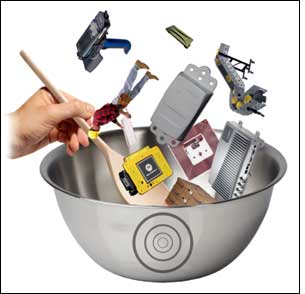Aug 01, 2009Want to buy a mobile phone? No problem—just go to counter #1 to choose your LCD, counter #2 to get your main board and #3 for the keypad, then go home and put it all together and download the software from the Web to make it work.
If we asked consumers to assemble their own units, do you think cell phone use would be so ubiquitous around the world? Of course not—but that's what the RFID industry has been asking its customers to do for years. While many companies recognize that tracking assets with RFID can improve efficiencies and reduce costs, they steer clear of the technology because it's too complicated and frustrating to deploy. They also don't have a solid sense of how or where they'll achieve a return on their investment.
The problem is that until recently, putting an asset-tracking system in place required bringing a lot of different components together—tags from one vendor, interrogators from another company and software from yet another—and hiring someone else to install all the equipment and make sure it worked. RFID vendors were selling pieces and parts, and they were focused on the technology, not the solution.
But the industry has evolved, and both passive and active RFID technologies have matured immensely. It's no longer necessary to conduct 10- or 12-week studies on what kind of tag to use, how to install interrogators and so on. As a result, now there's a trend toward packaged solutions—taking a consumer approach to deploying the technology. This means that one company implements the solution, even if it requires a combination of technologies to provide the best ROI for the customer. There are packaged solutions for tracking assets in a facility or yard, or combining RFID with GPS to track containers en route. There are also specific solutions for IT assets, hospital equipment and patients, and art and other high-value assets.
This is good news for end users who don't care how the system works, as long as it will solve their specific problems and deliver value to their business. But end users do need to choose a solution provider that's an expert in their market. And they need to partner in the solution to make sure it can grow with both their near- and long-term needs, which can help lower the total cost of ownership.
At RFID Global Solution, we believe that the packaged-solution approach is beneficial not only to customers but also to the RFID industry. If vendors don't have to reinvent the wheel with each deployment or learn on the end user's dime, we'll be able to provide faster, more cost-efficient deployments, with realistic expectations of system performance.
We'll also be able to provide a solution that's transparent to the end user and easy to maintain. And we'll be able to solve specific business problems, and prove and quantify the ROI. This is what end users want. And until the vendor community can meet their needs, the RFID industry will continue to move more slowly than expected into the adoption curve.
Joe Leone is president and chief technology officer of RFID Global Solution, which provides turnkey and custom asset-visibility solutions for defense, government and commercial customers. Photo illustration: John Hull


